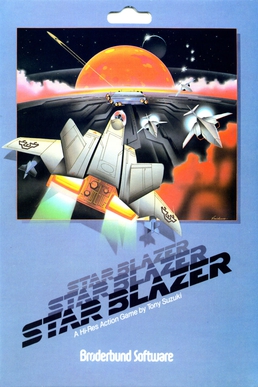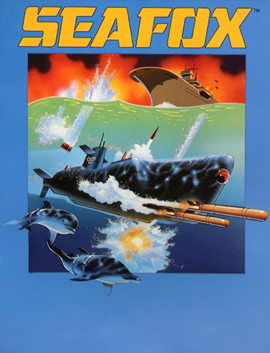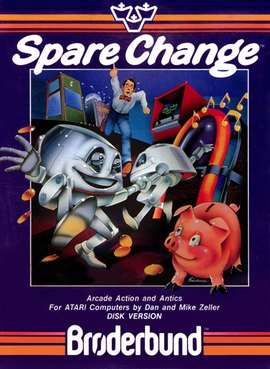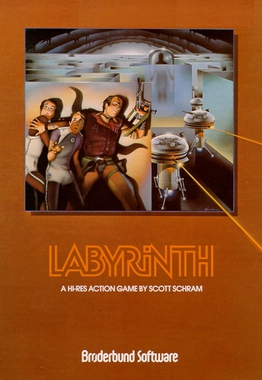
Centipede is a 1981 fixed shooter arcade video game developed and published by Atari, Inc. Designed by Dona Bailey and Ed Logg, it was one of the most commercially successful games from the golden age of arcade video games and one of the first with a significant female player base. The primary objective is to shoot all the segments of a centipede that winds down the playing field. An arcade sequel, Millipede, followed in 1982.

Frogger is a 1981 arcade action game developed by Konami and published by Sega. In North America, it was distributed by Sega/Gremlin. The object of the game is to direct five frogs to their homes by dodging traffic on a busy road, then crossing a river by jumping on floating logs and alligators.

Choplifter is a military themed scrolling shooter developed by Dan Gorlin for the Apple II and published by Broderbund in 1982. It was ported to Atari 8-bit computers the same year and also to the VIC-20, Commodore 64, Atari 5200, ColecoVision, MSX, and Thomson computers.

David's Midnight Magic is a pinball simulation video game written by David Snider for the Apple II and published by Broderbund in 1982. The game was published in Europe by Ariolasoft. A port to Atari 8-bit computers was released the same year, then the Commodore 64 in 1983. In 1987 Atari Corporation published a cartridge version in the styling of the then-new Atari XEGS.

Shamus is a shooter with light action-adventure game elements written by Cathryn Mataga and published by Synapse Software. The original Atari 8-bit computer version was released on disk and tape in 1982. According to Synapse co-founder Ihor Wolosenko, Shamus made the company famous by giving it a reputation for quality. "Funeral March of a Marionette", the theme song from Alfred Hitchcock Presents, plays on the title screen.

Drol is a video game published by Broderbund in 1983. It was written for the Apple II by Benny Aik Beng Ngo, then ported to the Commodore 64 and Atari 8-bit computers. Versions were released for the SG-1000 in 1985 and Amiga in 1991.
Synapse Software Corporation was an American software developer and publisher founded in 1981 by Ihor Wolosenko and Ken Grant. Synapse published application software and developer tools and was primarily known for video games. It initially focused on the Atari 8-bit computers, then later developed for the Commodore 64 and other systems. Synapse was purchased by Broderbund in late 1984 and the Synapse label retired in 1985.

Crossfire is a multidirectional shooter created by Jay Sullivan for the Apple II and published by On-Line Systems in 1981. Using keyboard-based twin-stick shooter controls, the player maneuvers a ship in a grid-like maze. Versions with joystick-control use the stick for movement and switch to firing mode when the button is held down.

Jungler is an arcade maze game developed by Konami and released in 1981. Distributed by Stern in the United States beginning in 1982, the game has players controlling a multi-segmented creature attempting to destroy similar enemy creatures by either shooting them or eating them. A sequel titled Battle Jungler was planned for the PC Engine on 1992, but was cancelled.

Bandits is a 1982 fixed shooter written by Tony and Benny Ngo for the Apple II and published by Sirius Software. The game is a clone of Taito's 1980 Stratovox arcade video game where the goal is to prevent aliens from stealing objects. Bandits was ported to the Atari 8-bit computers, Commodore 64, and VIC-20.

Gumball is a video game written for the Apple II by Veda Hlubinka-Cook and published by Broderbund in 1983. It was ported to the Atari 8-bit computers, and Commodore 64. The player controls the valves of a maze-like machine to sort gumballs by color.

Night Mission Pinball is a pinball simulation video game published by Sublogic in 1982. It was developed by Bruce Artwick for the Apple II, then ported to the Atari 8-bit family, Commodore 64, and IBM PC.

Bug Attack is a fixed shooter video game written by Jim Nitchals for the Apple II and published by Cavalier Computer in 1981. An version for Atari 8-bit computers was released in 1982. Bug Attack is based on Atari, Inc.'s Centipede arcade game.

Track Attack is a train-themed action game written by Chris Jochumson for the Apple II. It was published in 1982 by Broderbund, as was a port for Atari 8-bit computers by Bill Hooper. Track Attack contains both overhead maze levels and side-scrolling platform game levels. In the latter, the player controls a character who runs along the top of a train, performing acrobatic leaps between the cars. Jochumson co-authored The Arcade Machine which was released the same year.

Star Blazer is a horizontally scrolling shooter programmed by Tony Suzuki for the Apple II and published by Broderbund Software in 1982. A version for Atari 8-bit computers was released in 1983 as Sky Blazer.

Seafox is a shoot 'em up written by Ed Hobbs and published by Broderbund in 1982 for the Apple II and as a cartridge for Atari 8-bit computers. A VIC-20 port, also on cartridge, was released in 1983.

Spare Change is an action game designed by Dan and Mike Zeller and published in 1983 by Broderbund for the Apple II and Atari 8-bit computers. A Commodore 64 version was written by Steven Ohmert and released the same year. Ports for FM-7 and Sharp X1 were released in 1985. The difficulty of Spare Change can be customized through seven settings at the "Zerks Control Panel".

A.E. is a fixed shooter written by Jun Wada and Makoto Horai for the Apple II and Atari 8-bit computers and published by Broderbund in 1982. Versions followed for the VIC-20 (1983) and MSX (1984). Unlike most earlier shooters which have a solid color or starfield as a background, the action in A.E. takes place in front of science fiction scenes. Attacking creatures emerge from points in the image, often appearing to come from behind objects. Combined with a slight scaling as they advance, there is the impression of depth.

Labyrinth is a maze shooter written by Scott Schram for the Apple II, published in 1982 by Broderbund. It was ported to the Atari 8-bit computers by Corey Kosak.



















